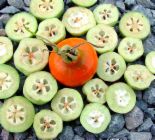|
|
About the Quince:
- Quinces are grown in central and southern Europe, Argentina, Chile, Uruguay, and the Middle East. They were once grown in New York, but pest problems limit their production today.
- The quince comes into season in late autumn, and is available through January, and again in Febuary and March.
- When the quince is ripe, the skin is yellow with hard flesh that is strongly perfumed.
The Benefits of the Quince:
- 1: The Quince is low in saturated fat, cholesterol, and sodium.
- 2: The Quince is high in vitamin C, Dietary fiber and copper.
- 3: The nutritional value and health benefits of the quince makes it ideal for helping to maintain optimum health and weight loss.
Other uses for the Quince: The quince has enjoyed a long history of use; in Medieval times, Europeans thought quinces aided the digestion, and so prepared them often with meat. Korean scholars in the 1700s and 1800s used quinces for tea as a substitute for Chinese tea. The British made wine from quinces in the 19th century that was reputed to benefit asthma sufferers. Quinces have many herbal medicinal uses also; they are used as an infusion to treat sore throat, diarrhoea, and hemmorage of the bowel. It is effective against inflammation of the mucous membranes, intestines and stomach. The stembark is used in Chinese medicine as an astringent for ulcers, and the fruits are used for various other remedies.
|



